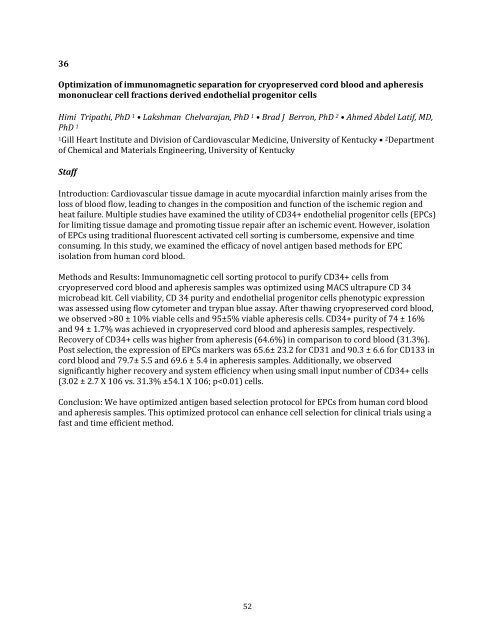2017 Cardiovascular Research Day Abstract Book
Create successful ePaper yourself
Turn your PDF publications into a flip-book with our unique Google optimized e-Paper software.
36<br />
Optimization of immunomagnetic separation for cryopreserved cord blood and apheresis<br />
mononuclear cell fractions derived endothelial progenitor cells<br />
Himi Tripathi, PhD 1 • Lakshman Chelvarajan, PhD 1 • Brad J Berron, PhD 2 • Ahmed Abdel Latif, MD,<br />
PhD 1<br />
1Gill Heart Institute and Division of <strong>Cardiovascular</strong> Medicine, University of Kentucky • 2 Department<br />
of Chemical and Materials Engineering, University of Kentucky<br />
Staff<br />
Introduction: <strong>Cardiovascular</strong> tissue damage in acute myocardial infarction mainly arises from the<br />
loss of blood flow, leading to changes in the composition and function of the ischemic region and<br />
heat failure. Multiple studies have examined the utility of CD34+ endothelial progenitor cells (EPCs)<br />
for limiting tissue damage and promoting tissue repair after an ischemic event. However, isolation<br />
of EPCs using traditional fluorescent activated cell sorting is cumbersome, expensive and time<br />
consuming. In this study, we examined the efficacy of novel antigen based methods for EPC<br />
isolation from human cord blood.<br />
Methods and Results: Immunomagnetic cell sorting protocol to purify CD34+ cells from<br />
cryopreserved cord blood and apheresis samples was optimized using MACS ultrapure CD 34<br />
microbead kit. Cell viability, CD 34 purity and endothelial progenitor cells phenotypic expression<br />
was assessed using flow cytometer and trypan blue assay. After thawing cryopreserved cord blood,<br />
we observed >80 ± 10% viable cells and 95±5% viable apheresis cells. CD34+ purity of 74 ± 16%<br />
and 94 ± 1.7% was achieved in cryopreserved cord blood and apheresis samples, respectively.<br />
Recovery of CD34+ cells was higher from apheresis (64.6%) in comparison to cord blood (31.3%).<br />
Post selection, the expression of EPCs markers was 65.6± 23.2 for CD31 and 90.3 ± 6.6 for CD133 in<br />
cord blood and 79.7± 5.5 and 69.6 ± 5.4 in apheresis samples. Additionally, we observed<br />
significantly higher recovery and system efficiency when using small input number of CD34+ cells<br />
(3.02 ± 2.7 X 106 vs. 31.3% ±54.1 X 106; p


